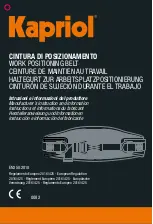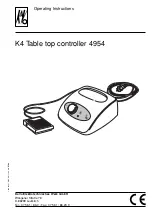
A C T G L O B A L . C O M / S P O R T S - T U R F
|
E M A I L :
S P O R T S @ A C T G L O B A L . C O M
MAINTENANCE MANUAL
17
Painting an Act Global surfacing systems with brushes
or rollers is not recommended. Spraying equipment is rec-
ommended for the following four reasons:
1. Spraying can make a more uniform paint application.
2. A more intricate template can be used if the paint is
sprayed.
3. Paint can be applied more rapidly with spray tech-
niques.
4. Paint can be removed more easily from areas that
have been correctly sprayed than from areas on
which the paint has been rolled.
Paint removal
The main key to efficient removal of temporary paint
from surfaces is the initial control in the application. The
use of excessive amounts of paints is wasteful, presents
abrasion hazards to players and requires extra work in
removal.
Equipment needed for Paint Removal
Use a street broom, deck brush, small sprayer or watering
can, water hose, medium sized tank or bucket for mixing,
and a couple of wet vacuums.
Materials Needed
Paint removal method requires the use of 8% ammonia.
The solution should be prepared in advance and access
to water outlets provided. The 8% ammonia solution is
prepared from aqua ammonia (33% ammonia) by diluting
with three parts water to one part aqua ammonia.
Caution
Aqua ammonia is a strong chemical. Follow the seller’s
instruction for handling – including eye protection, avoid-
ing skin contact, etc. Ammonia is very corrosive to copper
alloys do not use brass nozzles or fittings. For mixing, use
galvanized watering cans and a sprayer tank at all times.
Procedures
Hose down the painted area with water until the surface
is saturated. Using a sprayer or a watering can, apply the
ammonia solution on the painted area. It is important
that the ammonia solution be metered out uniformly at
the rate of one gallon per 45 to 50 square feet. Scrub the
wet area with a street broom until the ammonia solution
turns to foam. A sweeping motion similar to sweeping a
floor is sufficient. During this step, the paint will start to
loosen and the pigment will begin to run. However, do not
shorten the sweeping at this point.
Wait about 10 minutes to allow the foamed ammonia to
work. Apply the same amount of ammonia solution on
the area a second time. Thoroughly scrub the area with a
street broom. This scrubbing is not intended to be a light
scrub, scrub vigorously.
Hose down the area with water and simultaneously pick
up the water and dislodged paint residue with the wet
vacuum. Do not let the water and paint residue seep
across the field. If the residue and water start to spread,
stop the hosing and let the wet vacuum catch up. Repeat
the process if necessary. However, if the paint was ap-
plied lightly and uniformly, repeating the process should
not be necessary.














































